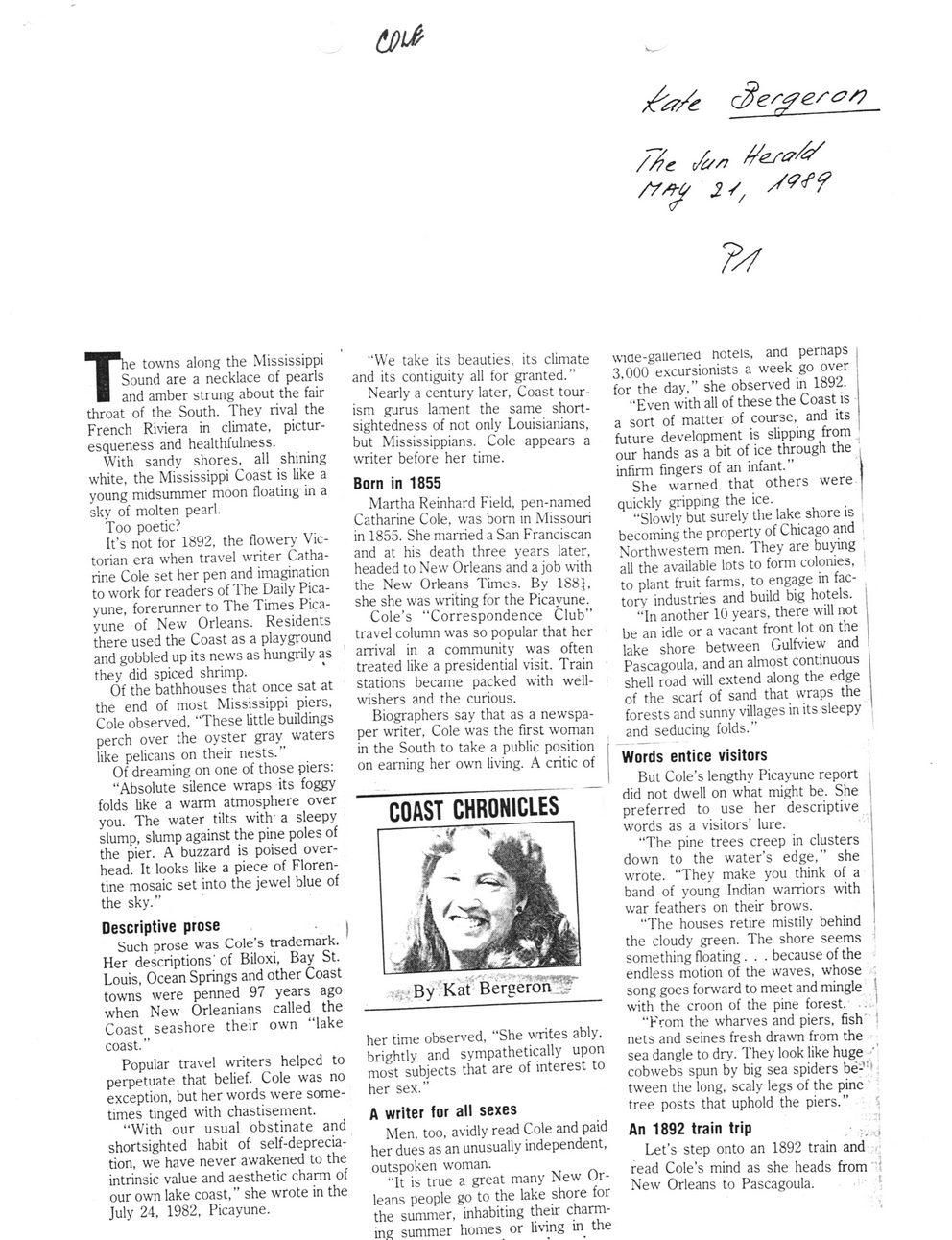This text was obtained via automated optical character recognition.
It has not been edited and may therefore contain several errors.
(Pll //?e 2 ?, 3/ The towns along the Mississippi Sound are a necklace of pearls and amber strung about the fair throat of the South. They rival the French Riviera in climate, picturesqueness and healthfulness. With sandy shores, all shining white, the Mississippi Coast is like a young midsummer moon floating in a sky of molten pearl. Too poetic? It?s not for 1892, the flowery Victorian era when travel writer Catharine Cole set her pen and imagination to work for readers of The Daily Picayune, forerunner to The Times Picayune of New Orleans. Residents there used the Coast as a playground and gobbled up its news as hungrily as they did spiced shrimp. Of the bathhouses that once sat at the end of most Mississippi piers, Cole observed, ?These little buildings perch over the oyster gray waters like pelicans on their nests.? Of dreaming on one of those piers: ?Absolute silence wraps its foggy folds like a warm atmosphere over you. The water tilts with' a sleepy slump, slump against the pine poles of the pier. A buzzard is poised overhead. It looks like a piece of Florentine mosaic set into the jewel blue of the sky. ? Descriptive prose Such prose was Cole's trademark. Her descriptions' of Biloxi, Bay St. Louis, Ocean Springs and other Coast towns were penned 97 years ago when New Orleanians called the Coast seashore their own ?lake coast.? Popular travel writers helped to perpetuate that belief. Cole was no exception, but her words were sometimes tinged with chastisement. ?With our usual obstinate and shortsighted habit of self-depreciation, we have never awakened to the intrinsic value and aesthetic charm of our own lake coast, ? she wrote in the July 24, 1982, Picayune. "We take its beauties, its climate and its contiguity all for granted.? Nearly a century later, Coast tourism gurus lament the same shortsightedness of not only Louisianians, but Mississippians. Cole appears a writer before her time. Born in 1855 Martha Reinhard Field, pen-named Catharine Cole, was bom in Missouri in 1855. She married a San Franciscan and at his death three years later, headed to New Orleans and a job with the New Orleans Times. By 188*, she she was writing for the Picayune. Cole?s ?Correspondence Club? travel column was so popular that her arrival in a community was often treated like a presidential visit. Train stations became packed with well-wishers and the curious. Biographers say that as a newspaper writer, Cole was the first woman in the South to take a public position on earning her own living. A critic of COAST CHRONICLES . -V * ?at.' By ?Kat Bergeron'9^ her time observed, ?She writes ably, brightly and sympathetically upon most subjects that are of interest to her sex.? A writer for all sexes Men, too, avidly read Cole and paid her dues as an unusually independent, outspoken woman. ?It is true a great many New Orleans people go to the lake shore for the summer, inhabiting their charming summer homes or living in the wiae-gauened notels, and perhaps 3,000 excursionists a week go over for the day,? she observed in 1892. ?Even with all of these the Coast is a sort of matter of course, and its future development is slipping from our hands as a bit of ice through the , infirm fingers of an infant.? J She warned that others were quickly gripping the ice. ' ?Slowly but surely the lake shore is | becoming the property of Chicago and Northwestern men. They are buying all the available lots to form colonies, to plant fruit farms, to engage in factory industries and build big hotels, j ?In another 10 years, there will not be an idle or a vacant front lot on the lake shore between Gulfview and Pascagoula, and an almost continuous shell road will extend along the edge of the scarf of sand that wraps the forests and sunny villages in its sleepy and seducing folds.? Words entice visitors But Cole?s lengthy Picayune report did not dwell on what might be. She preferred to use her descriptive words as a visitors? lure. ?The pine trees creep in clusters down to the water?s edge,? she wrote. ?They make you think of a band of young Indian warriors with war feathers on their brows. ?The houses retire mistily behind the cloudy green. The shore seems something floating. . . because of the endless motion of the waves, whose song goes forward to meet and mingle ! with the croon of the pine forest. .. ?From the wharves and piers, fish' I nets and seines fresh drawn from the sea dangle to dry. They look like huge '' cobwebs spun by big sea spiders be-: tween the long, scaly legs of the pine tree posts that uphold the piers.? 5 An 1892 train trip . ,.J Let?s step onto an 1892 train and read Cole?s mind as she heads from "j New Orleans to Pascagoula.

Artists Local 14